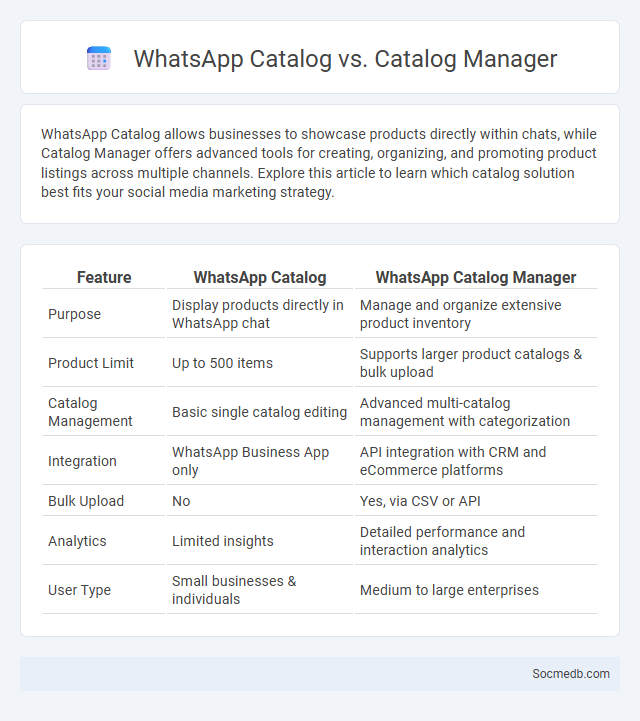
Photo illustration: WhatsApp Catalog vs Catalog Manager
WhatsApp Catalog allows businesses to showcase products directly within chats, while Catalog Manager offers advanced tools for creating, organizing, and promoting product listings across multiple channels. Explore this article to learn which catalog solution best fits your social media marketing strategy.
Table of Comparison
| Feature | WhatsApp Catalog | WhatsApp Catalog Manager |
|---|---|---|
| Purpose | Display products directly in WhatsApp chat | Manage and organize extensive product inventory |
| Product Limit | Up to 500 items | Supports larger product catalogs & bulk upload |
| Catalog Management | Basic single catalog editing | Advanced multi-catalog management with categorization |
| Integration | WhatsApp Business App only | API integration with CRM and eCommerce platforms |
| Bulk Upload | No | Yes, via CSV or API |
| Analytics | Limited insights | Detailed performance and interaction analytics |
| User Type | Small businesses & individuals | Medium to large enterprises |
Introduction to WhatsApp Catalog, Catalog Manager, and Catalog
WhatsApp Catalog allows businesses to showcase their products and services directly within the app, making browsing and purchasing seamless for your customers. Using Catalog Manager, you can efficiently organize and update product listings, ensuring accurate descriptions, prices, and images are always available. This feature empowers businesses to enhance customer engagement by providing a user-friendly digital shopping experience on WhatsApp.
What is WhatsApp Catalog?
WhatsApp Catalog is a feature within WhatsApp Business that allows businesses to showcase their products and services directly through the app, enabling customers to browse items without leaving the chat. It streamlines the shopping experience by displaying images, descriptions, prices, and product codes, helping small and medium enterprises increase sales and improve customer engagement. The catalog enhances digital marketing strategies by providing a convenient, user-friendly platform for product discovery and order placement.
Overview of Catalog Manager
Catalog Manager efficiently organizes your product listings across social media platforms, streamlining inventory management and enhancing ad campaigns. It integrates seamlessly with Facebook and Instagram, allowing real-time updates and customized product sets to target specific audiences. By leveraging Catalog Manager, you optimize your social media marketing strategy and boost sales performance through precise product visibility.
Understanding the Generic Catalog
Understanding the Generic Catalog in social media involves grasping how diverse content types, user interactions, and platform algorithms collectively shape your online presence. This catalog categorizes posts, stories, videos, and ads based on metadata, engagement metrics, and audience preferences to optimize visibility and reach. By strategically navigating these organized data sets, you can enhance content targeting and improve overall social media performance.
Core Features Comparison
Social media platforms differ significantly in core features such as content formats, user interaction, and privacy controls. YouTube specializes in video sharing with advanced monetization tools, while Instagram emphasizes visual storytelling through photos and short videos. Facebook offers a comprehensive mix of community engagement, event organization, and marketplace functionalities, catering to diverse user needs.
Integration with E-commerce Platforms
Seamless integration of social media with e-commerce platforms enhances Your ability to reach target audiences and streamline the purchasing process. Features like shoppable posts and in-app checkout reduce friction, boosting conversion rates and sales. Leveraging data analytics from integrated platforms allows for personalized marketing strategies and improved customer engagement.
User Experience and Accessibility
Social media platforms prioritize User Experience by offering intuitive interfaces, personalized content feeds, and responsive design to ensure seamless interaction across devices. Accessibility features such as screen reader compatibility, keyboard navigation, and customizable text sizes enable users with disabilities to engage effectively. Optimizing these elements enhances Your ability to connect, share, and consume content without barriers.
Business Scalability and Flexibility
Social media platforms enhance business scalability by providing access to a global audience and enabling rapid market penetration with minimal investment. Your brand can leverage targeted advertising and real-time analytics to adapt campaigns instantly, ensuring flexibility in response to changing market trends. Efficient content distribution and customer engagement tools empower sustained growth and agile adjustments to business strategies.
Pros and Cons of Each Option
Facebook offers extensive networking with over 2.9 billion active users, ideal for community building and targeted advertising, but faces criticism for data privacy concerns and misinformation spread. Instagram excels in visual content sharing and influencer marketing, attracting younger demographics, yet algorithm changes can limit organic reach and increase ad dependency. Twitter provides real-time updates and public discourse with 450 million monthly users but struggles with harassment issues and character limits that may hinder detailed communication.
Choosing the Best Catalog Solution for Your Business
Selecting the best catalog solution for your business involves evaluating key features such as integration capabilities with social media platforms, user-friendly interface, and robust analytics tools. Prioritize solutions offering seamless synchronization with Facebook, Instagram, and Pinterest to boost product visibility and streamline ad campaigns. Effective catalog management enhances customer engagement, increases conversion rates, and maximizes ROI in social media marketing efforts.
 socmedb.com
socmedb.com